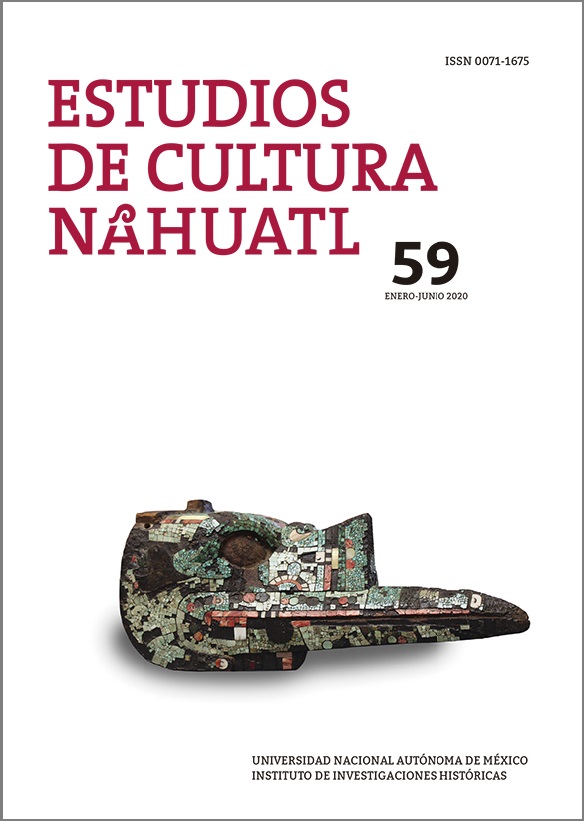Citas
- Acosta, Jorge. 1943. “Los colosos de Tula.” Cuadernos Americanos 2(6): 138–46.
- ______. 1956. “Resumen de los informes de las exploraciones arqueológicas en Tula, Hgo. durante las VI, VII y VII temporadas, 1946–1950.” Anales del Instituto Nacional de Antropología e Historia, 8: 37–115.
- Acosta Saignes, Miguel. 1945. Los Pochteca: ubicación de los mercaderes en la estructura social Tenochca. Mexico (Acta Anthropologica, I: 1).
- Adams, Richard. 1971. The Ceramics of Altar de Sacrificios. Cambridge: Papers of the Peabody Museum of Archaeology and Ethnology.
- Anales de Cuauhtitlan. 1938. In Die Geschichte der Kónigreiche von Colhuacan und Mexico. Text mit Uberselzung von Walter Lehmann. Quellenwerke zur alten Geschichte Amerikas aufgezeichnet in den Sprachen der Eingeborenen herausgegeben vom Ibero-Amerikanischen Institut. Stuttgart, Berlin.
- Armillas, Pedro. 1947. “La serpiente emplumada: Quetzalcoatl y Tlaloc.” Cuadernos Americanos, 1: 161–78.
- Bardawil, Lawrence. 1976. “The Principal Bird Deity in Maya Art — an Iconographic Study of Form and Meaning.” In The Art, Iconography and Dynastic History of Palenque, Part III: Proceedings of the Segunda Mesa Redonda de Palenque, December 14-21, edited by Merle Greene Robertson, 195–209. Pebble Beach, California: Pre-Columbian Art Research, Robert Louis Stevenson School.
- Barlow, Robert. 1945. “Review of Miguel Acosta Saignes, ‘Los Pochteca: ubicación de los mercaderes en la estructura social tenochca’”. Boletín Bibliográfico de Antropología Americana, 8: 164–66.
- Caso, Alfonso. 1966. “Dioses y signos teotihuacanos.” In Teotihuacan: Onceava Mesa Redonda, 249–79. Mexico: Sociedad Mexicana de Antropología.
- ______. 1967. Los calendarios prehispánicos. Mexico: Universidad Nacional Autónoma de México, Instituto de Investigaciones Históricas.
- Caso, Alfonso and Ignacio Bernal. 1952. Urnas de Oaxaca. Mexico: Instituto Nacional de Antropología e Historia.
- Codex Magliabechiano. 1970. Codex Magliabechiano CL.XIII.3 (B.R. 232). Biblioteca Nazionale Centrale di Firenze. Einleitung Summary und Resumen Ferdinand Anders. Graz, Austria: Akademische Druck-und Verlagsanstalt.
- Codex Telleriano-Remensis. 1899. Codex Telleriano-Remensis. Manuscrit Mexicain du cabinet de Ch.-M. Le Tellier, archevêque de Reims á la Bibliothéque Nationale (Ms. Mezicain No. 385). Reproduit en photochromographie aux frais du Duc de Loubat et précédé d’une introduction contenant la transcription complète des anciens commentaires Hispano-Mexicains per le Dr. E.-T. Hamy. Paris: Imp. Burdin.
- Codex Vaticanus A. 1900. Il Manoscritto Messicano Vaticano 3738 detto Il Codice Rios riprodotto in fotocromografía a spese di sua eccellenza il Duca di Loubat per cura della Biblioteca Vaticana. Rome: Danesi.
- Coe, Michael. 1975. Classic Maya Pottery at Dumbarton Oaks. Washington D.C.: Dumbarton Oaks.
- Díaz-Bolio, José. 1964. La serpiente emplumada: eje de culturas. Mérida, Yucatan: Registro de Cultura Yucateca.
- Díaz Infante, Fernando. 1963. Quetzalcoatl: ensayo psicoanalítico del mito nahua. Prólogo de Ángel Ma. Garibay K. Xalapa: Universidad Veracruzana.
- Du Solier, Wilfrido. 1943, A Reconnaissance on Isla de Sacrificios, Veracruz, Mexico. Washington D.C.: Carnegie Institution of Washington.
- Durán, fray Diego. 1967. Historia de las Indias de Nueva España e Islas de la Tierra Firme. La prepara y da a luz Ángel Ma. Garibay K. 2 vols. Mexico: Editorial Porrúa.
- Eliade, Mircea. 1974. The Myth of the Eternal Return or, Cosmos and History. Princeton: Princeton University Press.
- Florescano, Enrique. 1963. “Tula-Teotihuacan, Quetzalcóatl y la Toltecáyotl.” Historia Mexicana, 13(2): 193–234.
- ______. 1964. “La serpiente emplumada, Tláloc y Quetzalcóatl.” Cuadernos Americanos, 23 (2): 121–66.
- Franco, José Luis. 1961. “Tres representaciones fálicas de Ehecatl-Quetzalcoatl.” Boletín del Centro de Investigaciones Antropológicas de México, 12: 5–8.
- Gendrop, Paul. 1971. “Murales prehispánicos.” Artes de México, 18(144).
- Goldwater, Robert, Douglas Newton, Tamara Northern, and Julie Jones. 1969. Art of Oceania, Africa, and the Americas from the Museum of Primitive Art: An Exhibition at The Metropolitan Museum of Art, May 10-August 17, 1969. New York: Metropolitan Museum of Art.
- Greene, Merle, Robert Rands, and John Graham. 1972. Maya Sculpture from the Southern Lowlands, the Highlands and Pacific Piedmont: Guatemala, Mexico, Honduras. Berkeley: Lederer, Street & Zeus.
- Hedrick, Basil. 1967. Quetzalcoatl. Carbondale, Illinois: The Museum, Southern Illinois University.
- ______. 1971. “Quetzalcoatl: European or Indigene?” In Man across the Sea: Problems of pre-Columbian Contacts, edited by Carroll Riley, J. Charles Kelley, Campbell Pennington, and Robert Rands, 255–65. Austin: University of Texas Press.
- Joralemon, Peter David. 1971. A Study of Olmec Iconography. Washington D.C.: Dumbarton Oaks.
- Kampen, Michael. 1972. The Sculptures of El Tajín, Veracruz, Mexico. Gainesville: University Press of Florida.
- Kelley, David. 1965. “The Birth of the Gods at Palenque.” Estudios de Cultura Maya, 5: 93–134.
- Kubler, George. 1961. “Chichen-Itzá y Tula.” Estudios de Cultura Maya, 1: 47–49.
- ______. 1974. “Mythological Ancestries in Classic Maya Inscriptions.” In Primera Mesa Redonda de Palenque, Part II: A Conference on the Art, Iconography, and Dynastic History of Palenque, Palenque, Chiapas, Mexico, December 14–22, 1973, edited by Merle Greene Robertson, 23–43. Pebble Beach, California: Robert Louis Stevenson School.
- Lafaye, Jacques. 1974. Quetzalcoatl et Guadalupe. La formation de la conscience nationale au Mexique (1531–1813). Paris: Gallimard.
- ______. 1976. Quetzalcoatl and Guadalupe: The Formation of Mexican National Consciousness 1531–1813. Translated by Benjamin Keen. Chicago: University of Chicago Press.
- Lanczkowski, Günter. 1962. “Quetzalcoatl — Mythos und Geschichte.” Numen, 9(1): 17–36.
- León-Portilla, Miguel. 1968. Quetzalcóatl. Mexico: Fondo de Cultura Económica.
- López Austin, Alfredo. 1973. Hombre-dios: religión y política en el mundo náhuatl. Mexico: Universidad Nacional Autónoma de México, Instituto de Investigaciones Históricas.
- Lounsbury, Floyd. 1976. “A Rationale for the Initial Date of the Temple of the Cross at Palenque.” In The Art, Iconography and Dynastic History of Palenque, Part III: Proceedings of the Segunda Mesa Redonda de Palenque, December 14–21, 1974, edited by Merle Greene Roberton, 211–24. Pebble Beach, California: Robert louis Stevenson School.
- Matthews, Peter and Linda Schele. 1974. “Lords of Palenque — the Glyphic Evidence.” In Primera Mesa Redonda de Palenque, Part I: A Conference on the Art, Iconography, and Dynastic History of Palenque, Palenque, Chiapas, Mexico, December 14–22, 1973, edited by Merle Greene Robertson, 63–76. Pebble Beach, California: Robert Louis Stevenson School.
- Medellín Zenil, Alfonso. 1962. “El monolito de Maltrata, Veracruz.” La Palabra y el Hombre, 24: 555–61.
- Mendieta, fray Gerónimo de. 1945. Historia eclesiástica indiana. 4 vols. Mexico: Editorial Salvador Chávez Hayhoe.
- Nicholson, H. B. 1957. “Topiltzin Quetzalcoatl of Tollan: a Problem in Mesoamerican Ethnohistory”. Ph. D. dissertation, Department of Anthropology, Harvard University.
- ______. 1960. “The Mixteca-Puebla Concept in Mesoamerican Archaeology: a re-Examination.” In Men and Culture: Selected Papers from the Fifth International Congress of Anthropological and Ethnological Sciences, edited by Anthony F. C. Wallace, 612–17. Philadelphia: University of Pennsylvania Press.
- ______. 1971a. “The Iconography of Classic Central Veracruz Ceramic Sculptures.” In Ancient Art of Veracruz; an Exhibition Sponsored by the Ethnic Arts Council of Los Angeles at the Los Angeles County Museum of Natural History, February 23–June 13, 1971, edited by Olga Hammer, 13–17. Los Angeles: The Ethnic Arts Council.
- ______. 1971b. “Religion in pre-Hispanic Central Mexico.” In Handbook of Middle American Indians, vol. 10, Archaeology of Northern Mesoamerica, Part I, edited by Robert Wauchope (general editor), Gordon Ekholm and Ignacio Bernal (volume editors), 395–446. Austin: University of Texas Press.
- ______. 1976. “Preclassic Mesoamerican Iconography from the Perspective of the Postclassic: Problems in Interpretational Analysis.” In Origins of Religious Art and Iconography in Preclassic Mesoamerica, edited by H. B. Nicholson, 157–75. Los Angeles: UCLA Latin American Center Publications.
- ______. n.d., “The Deity 9. Wind ‘Ehecatl-Quetzalcoatl’ in the Mixteca Pictorials.” Paper presented at the XLI International Congress of Americanists, Mexico, D. F., September 2–7, 1974, in the special session, “Mixtec Codices: Problems and Progress”.
- Parsons, Lee. 1969. Bilbao, Guatemala: An Archaeological Study of the Pacific Coast Cotzumalhuapa Region. Vol. 2. Milwaukee: Milwaukee Public Museum.
- Pomar, Juan Bautista de. 1964. “Relación de Juan Bautista de Pomar (Tezcoco, 1582).” In Poesía Náhuatl, I, Romances de los Señores de la Nueva Espa- ña, Manuscrito de Juan Bautista de Pomar, Tezcoco, 1582, paleografía, versión, introducción, notas y apéndices de Ángel Ma. Garibay K. Mexico: Universidad Nacional Autónoma de México, Instituto de Investigaciones Historicas.
- Sáenz, César. 1962. Quetzalcoatl. Mexico: Instituto Nacional de Antropología e Historia.
- Sahagún, fray Bernardino de. 1905. Historia general de las cosas de Nueva España por Fr. Bernardino de Sahagún, edición parcial en facsimile de los códices matritenses en lengua mexicana que se custodian en las Bibliotecas del Palacio Real y de la Real Academia de la Historia. Edited by Francisco del Paso y Troncoso. Madrid.
- ______. 1950–69. Florentine Codex: General History of the Things of New Spain, edited and translated by Charles Dibble and Arthur Anderson. Parts 2–13. Santa Fe, New Mexico: School of American Research.
- Schele, Linda. n. d. The Attribution of Monumental Architecture to Specific Rulers at Palenque. Paper presented at the XLI International Congress of Americanists, Mexico, September 2–7, 1974.
- Séjourné, Laurette. 1959. Un palacio en la ciudad de los dioses (Teotihuacán). Mexico: Instituto Nacional de Antropología e Historia.
- ______. 1962. El universo de Quetzalcoatl. Mexico: Fondo de Cultura Económica.
- ______. 1965. “El Quetzalcóatl en Teotihuacan”. Cuadernos Americanos, 24 (1): 131–56.
- Seler, Eduard. 1900–01. The Tonalamatl of the Aubin Collection. An Old Mexican Picture Manuscript in the Paris National Library (Manuscrits Mexicains No. 18-19). English edition by A. H. Keane. Berlin: Published at the expense of his Excellency the Duke of Loubat.
- ______. 1902–23. Gesammelte Abhandlungen zur Amerikanischen Sprach- und Alter-tumskunde. 5 Vols. Berlin: A. Asher & Company.
- ______. 1963. Comentarios al Códice Borgia. 3 vols. México: Fondo de Cultura Económica.
- Thompson, J. Eric S. 1948. An Archaeological Reconnaissance in the Cotzumalhuapa Region, Escuintla, Guatemala. Washington D.C.: Carnegie Institution of Washington.
- Tozzer, Alfred. 1957. Chichen Itza and its Cenote of Sacrifice: a Comparative Study of Contemporaneous Maya and Toltec. 2 v ols. Cambridge: Peabody Museum of Archaeology and Ethnology, Harvard University.
- Willey, Gordon. n. d. “Mesoamerican Civilization and the Idea of Transcendence.” Antiquity: in press.
- Winning, Hasso von and Alfred Stendahl. n. d. Pre-Columbian Art of Mexico and Central America. New York.
Cómo citar
Licencia
Derechos de autor 2021 Estudios de Cultura Náhuatl

Esta obra está bajo una licencia internacional Creative Commons Atribución-NoComercial-SinDerivadas 4.0.
- Resumen visto - 735 veces
- PDF (English) descargado - 720 veces


 Estudios de Cultura Náhuatl se encuentra bajo una
Estudios de Cultura Náhuatl se encuentra bajo una 








